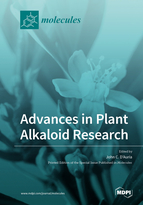Advances in Plant Alkaloid Research
A special issue of Molecules (ISSN 1420-3049). This special issue belongs to the section "Natural Products Chemistry".
Deadline for manuscript submissions: closed (15 September 2019) | Viewed by 120132
Special Issue Editor
Interests: tropane; chemical biology; metabolic engineering; secondary metabolism; alkaloids; plant biochemistry
Special Issues, Collections and Topics in MDPI journals
Special Issue Information
Dear Colleagues,
Plant alkaloids are critical components of modern medicine and pharmaceuticals. In addition, these compounds are also becoming increasingly important for industrial uses as part of the green chemistry revolution. This Special Issue will focus on the molecular advances being made in understanding how such a large and diverse class of compounds are made by plants and how metabolic engineering advances are increasing overall yield of crucial precursors.
Dr. John C. D'Auria
Guest Editor
Manuscript Submission Information
Manuscripts should be submitted online at www.mdpi.com by registering and logging in to this website. Once you are registered, click here to go to the submission form. Manuscripts can be submitted until the deadline. All submissions that pass pre-check are peer-reviewed. Accepted papers will be published continuously in the journal (as soon as accepted) and will be listed together on the special issue website. Research articles, review articles as well as short communications are invited. For planned papers, a title and short abstract (about 100 words) can be sent to the Editorial Office for announcement on this website.
Submitted manuscripts should not have been published previously, nor be under consideration for publication elsewhere (except conference proceedings papers). All manuscripts are thoroughly refereed through a single-blind peer-review process. A guide for authors and other relevant information for submission of manuscripts is available on the Instructions for Authors page. Molecules is an international peer-reviewed open access semimonthly journal published by MDPI.
Please visit the Instructions for Authors page before submitting a manuscript. The Article Processing Charge (APC) for publication in this open access journal is 2700 CHF (Swiss Francs). Submitted papers should be well formatted and use good English. Authors may use MDPI's English editing service prior to publication or during author revisions.
Keywords
- Evolution
- Benzylisoquinoline alkaloids
- Monoterpene-indole alkaloids
- Tropane alkaloids
- Metabolic engineering
- Tissue culture
- Enzyme







